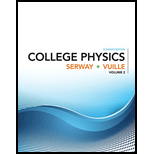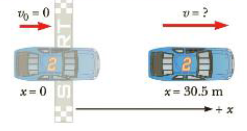
Concept explainers
PROBLEM A race car starting from rest accelerates at a constant rate of 5.00 m/s2, (a) What is the velocity of the car after it has traveled 1.00 × 102 ft? (b) How much time has elapsed? (c) Calculate the average velocity two different ways.
STRATEGY We’ve read the problem, drawn the diagram in Figure 2.16, and chosen a coordinate system (steps 1 and 2). We'd like to find the velocity v after a certain known displacement Δx. The acceleration a is also known, as is the initial velocity v0 (step 3, labeling, is complete), so the third equation in Table 2.4 looks most useful for solving part (a). Given the velocity, the first equation in Table 2.4 can then be used to find the time in part (b). Part (c) requires substitution into Equations 2.2 and 2.7, respectively.

Figure 2.16 (Example 2.4)
SOLUTION
(a) Convert units of Δx to SI, using the information in the inside front cover.
Write the
Solve for v, taking the positive square root because the car moves to the right (step 5):
Substitute v0 = 0, a = 5.00 m/s2, and Δx = 30.5 m:
1.00 × 102ft = (1.00 × 102 ft)
v2 = v02 + 2a Δx
v =
v =
(b) Find the trooper's speed at that time. Substitute the time into the trooper’s velocity equation:
vtrooper = v0 + atrooper t = 0 + (3.00m/s2)(16.9s)
= 50.7 m/s
Solve Example 2.5, “Car Chase,” by a graphical method. On the same graph, plot position versus time for the car and the trooper. From the intersection of the two curves, read the time at which the trooper overtakes the car.
Trending nowThis is a popular solution!

Chapter 2 Solutions
COLLEGE PHYSICS,V.2
Additional Science Textbook Solutions
College Physics: A Strategic Approach (3rd Edition)
Fundamentals Of Thermodynamics
MARINE BIOLOGY
Applications and Investigations in Earth Science (9th Edition)
Campbell Biology (11th Edition)
- Help me make a visualize experimental setup using a word document. For the theory below.arrow_forwardHow to solve this, given answerarrow_forwardThree point-like charges are placed at the corners of a square as shown in the figure, 28.0 cm on each side. Find the minimum amount of work required by an external force to move the charge q1 to infinity. Let q1=-2.10 μC, q2=+2.40 μС, q3=+3.60 μC.arrow_forward
- A point charge of -4.00 nC is at the origin, and a second point charge of 6.00 nC is on the x axis at x= 0.820 mm . Find the magnitude and direction of the electric field at each of the following points on the x axis. x2 = 19.0 cmarrow_forwardFour point-like charges are placed as shown in the figure, three of them are at the corners and one at the center of a square, 36.0 cm on each side. What is the electric potential at the empty corner? Let q1=q3=+26.0 µС, q2=-28.0 μC, and q4=-48.0μc Varrow_forwardPLS HELparrow_forward
 College PhysicsPhysicsISBN:9781305952300Author:Raymond A. Serway, Chris VuillePublisher:Cengage Learning
College PhysicsPhysicsISBN:9781305952300Author:Raymond A. Serway, Chris VuillePublisher:Cengage Learning College PhysicsPhysicsISBN:9781285737027Author:Raymond A. Serway, Chris VuillePublisher:Cengage Learning
College PhysicsPhysicsISBN:9781285737027Author:Raymond A. Serway, Chris VuillePublisher:Cengage Learning University Physics Volume 1PhysicsISBN:9781938168277Author:William Moebs, Samuel J. Ling, Jeff SannyPublisher:OpenStax - Rice University
University Physics Volume 1PhysicsISBN:9781938168277Author:William Moebs, Samuel J. Ling, Jeff SannyPublisher:OpenStax - Rice University Physics for Scientists and Engineers: Foundations...PhysicsISBN:9781133939146Author:Katz, Debora M.Publisher:Cengage Learning
Physics for Scientists and Engineers: Foundations...PhysicsISBN:9781133939146Author:Katz, Debora M.Publisher:Cengage Learning Glencoe Physics: Principles and Problems, Student...PhysicsISBN:9780078807213Author:Paul W. ZitzewitzPublisher:Glencoe/McGraw-Hill
Glencoe Physics: Principles and Problems, Student...PhysicsISBN:9780078807213Author:Paul W. ZitzewitzPublisher:Glencoe/McGraw-Hill Principles of Physics: A Calculus-Based TextPhysicsISBN:9781133104261Author:Raymond A. Serway, John W. JewettPublisher:Cengage Learning
Principles of Physics: A Calculus-Based TextPhysicsISBN:9781133104261Author:Raymond A. Serway, John W. JewettPublisher:Cengage Learning





